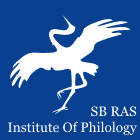 |
|
||||||||||||
|
Institute of Philology of
the Siberian Branch of Russian Academy of Sciences |
|
||||||||||||
|
|||||||||||||
| Sibirskii Filologicheskii Zhurnal (Siberian Journal of Philology) | |
|
Article
Authors: T. G. Skrebtsova St. Petersburg State University, St. Petersburg, Russian Federation In the section Linguistics
Abstract: In the present study, lexicalized forms of the Russian perception verbs are treated from the construction grammar perspective. The lexicalized forms were drawn from the modern dictionaries of Standard Russian and supplied with appropriate usage examples from the Russian National Corpus. The paper presents a detailed overview of the forms concerned, encompassing both their formal and semantic features. Each lexicalized form is argued to be a construction, in the special sense accorded to the term in construction grammar. Moreover, not only lexicalized forms as listed in the dictionaries but also their specific instantiations (allowing for the variability of the verb form and the addition of extra elements, e.g., particles) are claimed to be constructions. The paper particularly focuses on the analysis of manifold relations between constructions. In construction grammar, this problem has been given scanty coverage, scholars largely concentrating on taxonomic relations between more and less schematic con- structions. This particular type of relations can be said to manifest itself in the links between lexicalized forms and their instantiations. However, the data at hand make it possible to identify a number of other relations. These include the links between lexicalized forms and the corresponding verb as well as semantic relations including homonymy and polysemy, complete and partial synonymy. Taken together, they form an integrated network of relations, both formal and semantic. This is natural, given the fact that the corresponding verbs belong to the same lexical group. The paper argues for the term constructional family to be used in such cases. The constructional family is thus a subset of constructional networks. Keywords: verbs of perception, lexicalization, construction grammar Bibliography: Bogaert J. van. I think and other complement-taking mental predicates: A case of and for constructional grammaticalization. Linguistics. 2011, vol. 49, no. 2, pp. 295– 332. Cappelle B. Particle placement and the case for “allostructions”. Constructions. 2006, SV1-7, pp. 1–28. Croft W., Cruse D. A. Cognitive linguistics. Cambridge, CUP, 2004, 356 p. Diessel H. Usage-based construction grammar. Handbook of cognitive linguistics. E. Dąbrowska, D. Divjak (Eds.). Berlin, Mouton de Gruyter, 2015, pp. 295–321. Goldberg A. E. Constructions: a construction grammar approach to argument structure. Chicago, The Univ. of Chicago Press, 1995, 265 p. Kretov A. A. Organizatsiya leksiko-semanticheskoy gruppy zritel’nogo vospriyatiya v indoevropeyskikh yazykakh [Organization of lexical-semantic group of visual perception in the Indo-European languages]. In: Semanticheskie kategorii sopostavitel’nogo izucheniya russkogo yazyka [Semantic categories of the comparative study of Russian language]. Voronezh, VSU Publ., 1981, pp. 107–114. Leksiko-semanticheskie gruppy russkikh glagolov: Uchebnyy slov.-sprav. [Lexical-semantic groups of Russian verbs: Educational dictionary]. T. V. Matveeva (Ed.). Sverdlovsk, UrSU, 1988, 154 p. Norde M. On parents and peers in constructional networks. 2014. URL: https:// www.academia.edu/9873697/On_parents_and_peers_in_constructional_networks (accessed: 11.11.2019). Skrebtsova T. G. Kognitivnaya lingvistika: klassicheskie teorii, novye podkhody [Cognitive linguistics: classical theories, new approaches]. Moscow, ID YaSK, 2018, 392 p. Sweetser E. From etymology to pragmatics. Cambridge, CUP, 1990, 174 p. Traugott E. C. “All that he endeavoured to prove was...”: On the emergence of grammatical constructions in dialogic contexts. In: Language in flux: dialogue coordination, language variation, change and evolution. R. Cooper, R. Kempson (Eds.). London, King’s College Publications, 2008b, pp. 143–177. Traugott E. C. Grammaticalization, constructions and the incremental development of language: Suggestions from the development of degree modifiers in English. In: Variation, selection, development – probing the evolution model of language change. Eds. R. Eckardt, G. Jäger, T. Veenstra (Eds.). Berlin, Mouton de Gruyter, 2008a, pp. 219– 250. Traugott E. C., Trousdale G. Constructionalization and constructional changes. Oxford, OUP, 2013, 304 p. Vasil’ev L. M. Semanticheskie klassy glagolov chuvstva, mysli i rechi [Semantic classes of verbs of feeling, thought and speech]. In: Ocherki po semantike russkogo glagola [Essays on the semantics of the Russian verb]. Ufa, Bashkir State Univ., 1971, pp. 38–310. Vasil’ev L. M. Semantika russkogo glagola [Semantics of a Russian verb]. Moscow, Vyssh. shk., 1981, 184 p. Velde F. van de. Degeneracy: the maintenance of constructional networks. In: Extending the scope of construction grammar. R. Boogaart, T. Colleman, G. Rutten (Eds.). Berlin, Mouton de Gruyter, 2014, pp. 141–179. |
 |
Institute of Philology Nikolaeva st., 8, Novosibirsk, 630090, Russian Federation +7-383-330-15-18, ifl@philology.nsc.ru |
© Institute of Philology |


